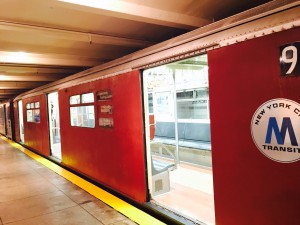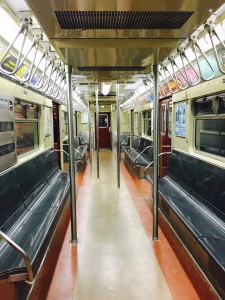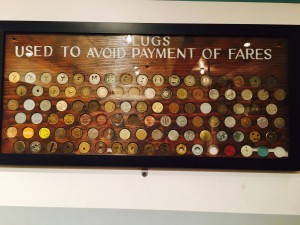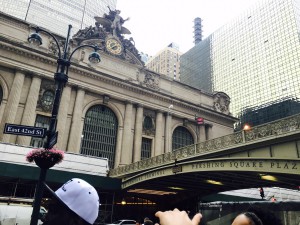Listening to the Bowery Brother’s Podcast was interesting. I tended to notice the style of the podcast more, and realized how professional and clean cut the podcast was (as compared to my own rendition of a “podcast”). I couldn’t help but realize that most of the podcast was basic information that we learned as a class from the first couple of classes when we explored the topic of GCT, and I wasn’t as engaged as I was while watching videos that had most of the same information. I feel like listening to history is harder to focus on, while visually experiencing it is more interesting. However, I thought it was interesting that we were able to get most of all the basic information of GCT through an assortment of mediums. We were able to read about the iterations of the depot, and the transition of the locomotives etc, then we were able to visually see this information through videos that we watched in class, then we took the tours of GCT where we were able to first hand experience the space of GCT.. so listening to the podcast was kind of taking a step back. I do think that it was an interesting stylistic way of sharing information through a podcast, and it helped me to understand the way a podcast should sound like (something that we have to do for the final project).
Author Archives: aniqa_4001
GCT Site Report 1
Wilgus Papers
Looking at the William J Wilgus Papers really makes me appreciate the “finding aid” tool since it encapsulates the entirety of the collection in a single neat and organized source. The papers are extensive, and if they were not organized, I shudder to think of the intray of the person who would be interested in Wilgus’ life.
As the Wilgus papers are extensive, and one can see the sheer amount of data that is present- the finding aid acts as a type of organizer for the documents, and makes each section (and subsection) easier to access and browse through. To me a finding aid is kind of like tabs in a binder- each tab represents a portion of data that is relevant to that sub heading. Finding aids are also more than just subsections- they also summarize the entire collection (which in Wilgus’ case was very helpful since I found reading his entire bio very daunting), where the collection came from (collection overview), biographical information, the scope and arrangement of the collection (most useful for research since this shows where to go when looking for specific topics or specific years), administrative information (which shows where the collection is located at), key terms (which help in finding this collection for researchers), and using the collection (the physical location of the collection and how to get your hands on it).
Finding aids are metadata on the data that is being researched. It is the information that makes researching easier to understand and easier to browse through in order to find the specific information that you need to write your paper or report, etc. William Wilgus seemed like an extremely interesting person with a lively and demanding architectural career (which I gleaned by browsing just the detailed description of the collection!)
Library Book: Grand Central Terminal: Gateway to a Million Lives
I was unaware before that we were supposed to add our library book’s contents on openlab (I had it in my notebook):
“Grand Central Terminal: Gateway to a Million Lives:”
This book talks about the history of how GCT came to be. It talks about before the construction of GCT, during the process of GCT being constructed, and then how GCT grew and declined. The book also goes over the restoration of GCT and the beginning of the 21st century for GCT. It is a good source for someone wishing to understand how GCT was influenced throughout time.
Table of Contents:
I. Saving an archetype
II. Life before the terminal
III.How Grand Central became grand
IV. Real Estate and train travel
V. Home to the Nation
VI. Grand Central of the imagination
VII. The decline of Grand Central
VIII. The Restoration Cast Assembles
IX. Grand Central is Reborn
X. Grand Central as a bazaar
XI. Into the 21st Century
Transit Museum Reflection
Growing up as a kid, I remember the bright red 90s trains that would clickety clack their way through the city. Going to the transit museum was worth just being able to see those trains again, and being able to sit in them. It was also very interesting to be able to see the older version of trains- and it felt as though the older the train got, the more comfortable the seats became!
Another thing that really caught my attention at the transit museum was the different types of tokens that were used as forms of payment. For one thing, I always believed that metro cards were used far longer (early 90s at least) than they actually were (started being used in 2000s), and was surprised that up till 1995 tokens were used for the trains (I don’t remember tokens for the trains perhaps since I never had to buy them myself at that age). One of the other interesting parts of the museum that caught my attention was this mounted plaque with things called slugs- that were counterfeit tokens so that people could get past the turnstiles without paying. I thought it was extremely interesting and funny that the MTA had a copy of each type of counterfeit token for the ages.
GCT 100 year Panel Video
The PBS panel video on GCT’s 100 year anniversary was.. interesting. There were a lot of facts and figures, which I guess one would expect since every person there was an expert of some form that related to GCT. I wasn’t really as vested in this video compared to some of the others that we as a class watched- perhaps this was a little too cut and dry for me.
One of things that I did find to be interesting was how much Penn Station cropped up in the conversation- which yes, of course I knew it would be mentioned at some point- but I felt as though while some of the panel members thought that it was a shame that Penn Station was destroyed, others thought it was more of a stand alone building and the destruction of it was inevitable, while GCT had more going for it, which is why it still stands today. This I can understand, since I know that GCT has its own income that stems from the retail space that businesses inhabit in and GCT.
I think if we were to have watched this video as an introduction to GCT it would have peaked more interest- but since we already ventured in detail about GCT, getting a skimmed version of it wasn’t very captivating.
Penn Station Video Reflection
“Penn Station is a martyr that enabled Grand Central Terminal to be saved.”
This was probably the most frustrating line that the video talked about. I don’t believe that Penn Station was a martyr, because I see Penn Station as a victim. A victim to New Yorker’s ignorance of understanding the necessity to hold on to buildings that preserve history. I believe that we as New Yorkers are so keen and happy with the future, since we are always the first to every new gadget and gizmo on the market, that we forget what it means to preserve New York- that we as a city have our own history. The destruction of Penn Station isn’t JUST about the building; its about a beautiful piece of our history (the history of the effort of thousands of New Yorkers who put their sweat, blood, tears, and lives for the creation of Penn Station) that was allowed to be destroyed for capital, profit, and the “bottom line.” The most powerful emotion that passed through me while watching the video was when the actual pieces of Penn Station were being removed and the last shot of them lying a thither abandoned in some waste in NJ. Professor Philip’s reaction in our last GCT tour became crystal clear to me- when she was outraged that a hotel from Terminal City was being torn down to be replaced by a 70 story skyscraper- I completely understand your anguish Professor!
The video as a whole was extremely interesting, and I felt as though the video was very informative but also emotional in the sense that the struggle of bringing Penn Station to life was that of not only Alexander Cassatt, but numerous other workers, from engineers to the sandhogs who carefully and dutifully gave us Penn Station.
I believe that this video will haunt me every time I pass through 34th street, whether on the train or on foot or on car. Every time I hear “This is 34th Street Penn Station; transfer to the 3, …, and Amtrak” the footage of Penn Station being built, how the sheer enormity of its building was awe inspiring, and the destruction and waste of Penn Station will flash before my eyes. oh the heartache!
NYPL Site Report
Archival Reflection Assignment
The MTA Archival visit was extremely thought provoking because of how much there was to see! The MTA archives were filled with some amazing primary sources of GCT that depicted various times of and around the terminal. Looking at the sources, and knowing how GCT is today, gave me an interesting perspective on not just GCT, but also about how archives preserve a moment in time for future generations to look back at. I’m sure when the photographs that we saw were taken, no one thought much about the pictures, because they were still current and life probably seemed “boring” and dull. However, those same photographs of the terminal being built, and the surrounding areas of Bryant Park, and Times Square are priceless to us because of how unequivocally different that time is to this.
At the archive we were fortunate to meet with Haley, who accommodated us and was our archive proctor. She brought us some pretty interesting primary sources from the Metro North Collection, and also gave us some insightful information about finding aids (kind of like metadata- data about the sources, like what agency the source was organized by, the type of material, the date of the source, etc.), and about different materials that we looked at (cyanotype, etchings, gelatin coated).
There were two sources that I found extremely interesting. Unfortunately, the photograph that I really wanted to use as a source of GCT being built, I was unable to get. However, the other source was a wartime pamphlet:
Title: “Wartime Guide to Grand Central Terminal”
Creator/Publisher: NY Central System
Year: 1940
This source was extremely descriptive as well as intended as a visual aid. The source was in pamphlet format (a double gated pamphlet) and was intended as wartime paraphernalia most likely intended for to motivate troops and bring business to the terminal. It was published in 1940, which means that it was created during World War II.
The source is interesting because it shows the extent that GCT went in order to bring business, even in the time of warfare. To me it shows that GCT was able to become a center even in the face of war. This source would be vital in research for the uses of GCT, one of the uses also being a place where troops were being transported.
For further research:
What other uses of GCT arise over different periods of time? What use is being put to GCT today?
How did WWII effect the railroad business?
How did GCT cope with changing technological advances?
Grand Central Walking Tour II Reflection
The GCT walking tour last Thursday was extremely interesting, since we were able to experience the terminal through the eyes of an architectural enthusiast. The main focal point of last Thursday, wasn’t just the GCT building itself, but more of GCT and its surrounding buildings that made up Terminal City. Understanding the background information around a topic is crucial in understanding the topic itself, and I feel like understanding not just GCT but the surrounding era, the economy of the time, the surrounding buildings, and how they ended up becoming part of and the inspiration to something as grand as Terminal City is just as vital as actually understanding the GCT building and its own unique history.
What I found really interesting was the architectural similarities of GCT (especially the Pershing Square Viaduct) to Parisian architect (Alexander III Bridge). I really enjoyed how Tony (tour guide), explained how the love of Paris inspired Wilgus to bring Parisian elements into GCT. For me, it kind of shows how there are roots of Europe in our “New World” city. Yet for all our “New World” charm, we were still able to create our own statement with GCT.







